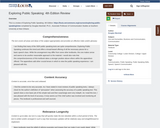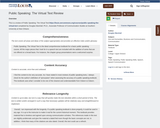I. Chapter 1: Introduction to Communication Studies
1. Communication: History and Forms
2. The Communication Process
3. Communication Competence
II. Chapter 2: Communication and Perception
4. Perception Process
5. Perceiving Others
6. Communication Principles
7. Perceiving and Presenting Self
8. Improving Perception
III. Chapter 3: Verbal Communication
9. Functions of Language
10. Using Words Effectively and Affectively
11. Language, Society, and Culture
12. Developing Your Ability to Use Effective Language in Public Speaking
IV. Chapter 4: Nonverbal Communication
13. Principles and Functions of Nonverbal Communication
14. Types of Nonverbal Communication
15. Nonverbal Communication Competence
16. Nonverbal Communication in Context
17. The Importance of Practicing Delivery
V. Chapter 5: Listening
18. Understanding How and Why We Listen
19. Improving Listening Competence
20. Listenable Messages and Effective Feedback
21. Listening in Public Speaking Settings
22. Value of Public Speaking in Your Life
VI. Chapter 6: Culture and Communication
23. Foundations of Culture and Identity
24. Exploring Specific Cultural Identities
25. Intercultural Communication
26. Intercultural Communication Competence
VII. Chapter 7: Interpersonal Communication Processes
27. Principles of Interpersonal Communication
28. Conflict and Interpersonal Communication
29. Emotions and Interpersonal Communication
30. Self-Disclosure and Interpersonal Communication
VIII. Chapter 8: Communication in Relationships
31. Foundations of Relationships
32. Communication and Friends
33. Communication and Families
34. Romantic Relationships
35. Relationships at Work
36. The Dark Side of Relationships
IX. Chapter 9: Small Group Communication
37. Understanding Small Groups
38. Small Group Development
39. Small Group Dynamics
40. Group Member Roles
41. Problem Solving and Decision Making in Groups
42. Leadership and Small Group Communication
X. Chapter 10: The Basics of Public Speaking
43. What is Public Speaking?
44. Anxiety and Public Speaking
45. Understanding the Process of Public Speaking
46. Getting Started in Public Speaking
XI. Chapter 11: Audience Analysis
47. The Importance of Audience Analysis
48. Demographic Characteristics
49. Psychographic Characteristics
50. Contextual Factors of Audience Analysis
XII. Chapter 12: Developing Topics for Your Speech
51. Getting Started with Your Topic and Purpose
52. Formulating a Specific Purpose Statement
53. Formulating a Central Idea Statement
54. Problems to Avoid with Specific Purpose and Central Idea Statements
XIII. Chapter 13: Researching Your Speeches
55. Primary and Secondary Research
56. Research on the Internet
57. Conducting Your Own Research
58. Accessing Information Through a Library
XIV. Chapter 14: Organizing and Outlining Your Speech
59. Why We Need Organization in Speeches
60. Patterns of Organization
61. Connective Statements
62. Outlining
XV. Chapter 15: Supporting Your Speech Ideas
63. Why Supporting Materials are Needed
64. Types of Supporting Materials
65. Attention Factors and Supporting Material
XVI. Chapter 16: Introductions and Conclusions
66. General Guidelines for Introductions and Conclusions
67. Structuring the Introduction and Examples
68. Structuring the Conclusion and Examples
XVII. Chapter 17: Presentation Aids in Speaking
69. What Are Presentation Aids?
70. Functions of Presentation Aids
71. Types of Presentation Aids
72. Using Presentation Slides
73. Low-Tech Presentation Aids
XVIII. Chapter 18: Informative Speaking
74. What is an Informative Speech?
75. Types of Informative Speeches
76. Guidelines for Selecting an Informative Speech Topic
77. Guidelines for Preparing an Informative Speech
XIX. Chapter 19: Persuasive Speaking
78. Why Persuade?
79. A Definition of Persuasion
80. Why is Persuasion Hard?
81. Traditional Views of Persuasion
82. Constructing a Persuasive Speech
XX. Chapter 20: Logical Reasoning
83. Inductive Reasoning
84. Deductive Reasoning
85. Logical Fallacies
XXI. Chapter 21: Special Occasion Speaking
86. Understanding Special Occasion Speeches
87. Types of Special Occasion Speeches
88. Special Occasion Preparation
Appendix A: Cultural Diversity in Public Speaking
Appendix B: Succeeding as a College Student
Appendix C: Public Speaking Online
Appendix D: Humor Appendix (is that anything like the funny bone?)
Appendix E: APA Citation
Appendix G: References






